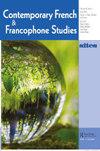Like the Playful Clones in the Forest: An Experiment in Reading Marie Darrieussecq’s Notre vie dans les forêts as an Instance of AI
IF 0.2
4区 文学
0 LITERATURE, ROMANCE
引用次数: 0
Abstract
AbstractMarie Darrieussecq’s Notre vie dans les forêts (2017) is a science-fiction novel about cloning. Alternatively, it could be described as a notebook composed by a fugitive clone named Viviane writing before her imminent death in the tunnels constructed beneath a forest on the ghostly fringes of an unnamed city. Viviane has unplugged from this socially engineered illusion by following one of her former patients and a member of a fugitive group of scavengers and hackers who free their anesthetized clones. But, the fugitives comically struggle to prepare their clones—who just want to play—for the egalitarian, just, and liberatory future in which they hope. In this paper, I first provide a close reading of the narrative of Darrieussecq’s novel, focusing on how it teaches us to read it subjunctively and contingently. I then argue that the clones’ playfulness expresses an energy source resistant to exploitation. I conclude with a hypothesis: the book itself could be understood as an instance of artificial intelligence that resists exploitation because it teaches us to read subjunctively, contingently, and playfully.Keywords: Darrieussecqscience fictionplaycloningAIreading AcknowledgmentThis paper was written with the aid of a Carolina Postdoctoral Program for Faculty Diversity fellowship at the University of North Carolina at Chapel Hill. I would like to thank my colleagues in the Department of Romance Studies, whose energizing comments about an early version of this paper have been invaluable. I would also like to thank the conference organizers and participants of the 39th Annual 20th and 21st Century French and Francophone Studies Colloquium at the University of Pittsburgh, where I presented a later version of this paper in March 2022. The generous feedback I received at the colloquium has been equally invaluable.Additional informationNotes on contributorsSean Singh MatharooSean Singh Matharoo is Assistant Professor & Jacques Hardré Fellow of French and Francophone Studies at the University of North Carolina at Chapel Hill, where he is writing The Damned of the Anthropocene: Performatively Modeling Energy Aesthetics for a New Structuralism.就像森林里好玩的克隆:阅读Marie Darrieussecq的《Notre vie dans les forêts》作为AI实例的实验
摘要marie Darrieussecq的《Notre vie dans les forêts》(2017)是一部关于克隆的科幻小说。或者,它可以被描述为一个名叫维维安(Viviane)的在逃克隆人在即将死亡之前写的笔记本,她在一个无名城市幽灵边缘的森林下建造的隧道里写作。薇薇安已经从这个社会设计的幻觉中解脱出来,她跟随她的一个前病人和一个逃犯组织的成员,这些组织的拾荒者和黑客释放了他们被麻醉的克隆体。但是,这些逃亡者滑稽地挣扎着让他们的克隆人——他们只是想玩——为他们所希望的平等、公正和解放的未来做准备。在本文中,我首先对达里乌塞克小说的叙事进行了细致的解读,重点是它如何教会我们进行主观和偶然的阅读。然后,我认为克隆动物的好玩性表达了一种抵抗剥削的能量来源。最后,我提出了一个假设:这本书本身可以被理解为一个抵制剥削的人工智能的例子,因为它教会我们下意识地、偶然地和开玩笑地阅读。本文是在北卡罗来纳大学教堂山分校(University of North Carolina at Chapel Hill)教师多样性博士后项目的帮助下完成的。我要感谢我在浪漫研究系的同事们,他们对这篇论文早期版本的积极评论是非常宝贵的。我还要感谢匹兹堡大学第39届20世纪和21世纪法语和法语国家研究年会的组织者和与会者,我于2022年3月在那里提交了本文的更新版本。我在研讨会上收到的慷慨反馈同样是无价的。作者简介:sean Singh Matharoo是北卡罗来纳大学教堂山分校法语和法语研究的助理教授兼雅克·哈德罗研究员,他正在撰写《人类世的诅咒:为新结构主义表演建模能量美学》。
本文章由计算机程序翻译,如有差异,请以英文原文为准。
求助全文
约1分钟内获得全文
求助全文
来源期刊

Contemporary French and Francophone Studies
LITERATURE, ROMANCE-
CiteScore
0.30
自引率
0.00%
发文量
43
期刊介绍:
An established journal of reference inviting all critical approaches on the latest debates and issues in the field, Contemporary French & Francophone Studies (formerly known as SITES) provides a forum not only for academics, but for novelists, poets, artists, journalists, and filmmakers as well. In addition to its focus on French and Francophone studies, one of the journal"s primary objectives is to reflect the interdisciplinary direction taken by the field and by the humanities and the arts in general. CF&FS is published five times per year, with four issues devoted to particular themes, and a fifth issue, “The Open Issue” welcoming non-thematic contributions.
 求助内容:
求助内容: 应助结果提醒方式:
应助结果提醒方式:


